
Toledo's police surveillance cameras credited with curbing crime
Mayor Collins not sold on devices
6/8/2014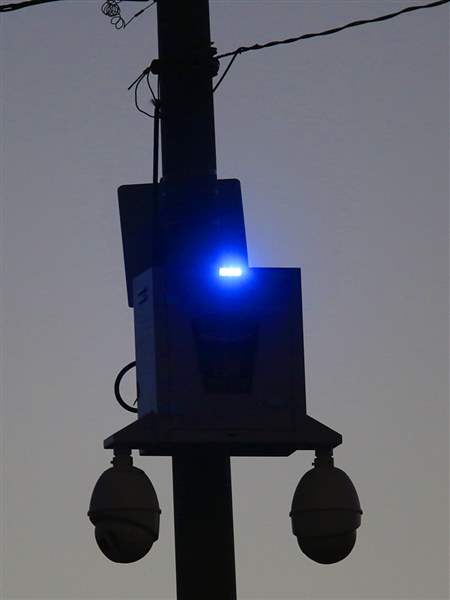
This police camera at Starr Avenue and East Broadway in East Toledo is among 147 installed across the city.
THE BLADE/ANDY MORRISON
Buy This Image
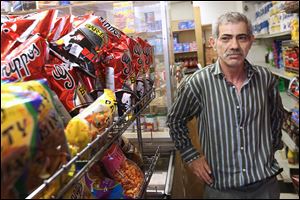
Amer Algazzawi, owner of a North Toledo carryout, says he has seen a decrease in trouble around his establishment since police posted a camera outside his shop.
Sometimes, when the shooting starts, Amer Algazzawi’s corner-store carryout turns into a safe haven — walls to protect those who are trying to make it through each day without becoming the next face printed on a T-shirt.

This police camera at Starr Avenue and East Broadway in East Toledo is among 147 installed across the city.
There has been an untold number of shootings outside his store at Walnut and North Michigan streets in North Toledo over the past few decades, but he has never considered moving or quitting. In fact, he’d like to expand — especially now that he feels the notoriously dangerous neighborhood is improving thanks, in part, to a police surveillance camera right outside the Walnut Carry-Out.

“There are less problems in the neighborhood since the camera,” Mr. Algazzawi said. “They’re shooting less outside. Less fights.”
For years, law enforcement agencies across the country have used cameras — private security and police-provided systems — to crack cases, including crimes of terrorism. Surveillance video was used after the Boston Marathon bombings last year to identify the two terrorist suspects. More recently, in Pittsburgh, police used video from various locations to catch a man who police allege brutally murdered his neighbors.
Nearly a decade ago, cameras in London, part of a system known as “Ring of Steel,” helped solve terrorist subway bombings there. Thousands of cameras allow police to monitor those entering and leaving central London. Cameras also started popping up across New York after the Sept. 11, 2001, terrorist attacks and were used to investigate a terror-bombing attempt in Times Square in 2010.
Recently, Chicago Transit Authority officials said crime throughout its system was declining after another expansion of camera use.
In the wake of last year’s Boston Marathon bombing, Fraternal Order of Police Executive Director Jim Pasco, in comments to Politico, supported the use of cameras in law enforcement. “Technology moves at a warp speed and provides a unique opportunity to enhance public safety in a time when resources are strained and communications and transportations are so sophisticated,” Mr. Pasco said.
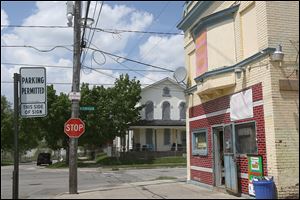
A police camera posted on Walnut Street outside of a small carryout store in North Toledo has made a noticeable difference, the store’s owner said. He added that it seemed like there had been a reduction in trouble-causing customers.
Collins’ position

Still, Toledo Mayor D. Michael Collins has expressed doubts about Toledo’s police-camera system and has not committed to the cameras’ future.
Whether the camera system expands beyond its current reach is undetermined, Mayor Collins said. He said he will examine crime data in the fall to look at “actual performance, not anecdotal. Then I can determine the value the cameras really provide.”
Police Chief William Moton said the cameras “are an asset” and “a positive attribute to crime fighting” but their effectiveness “remains to be seen.”
Mayor Collins, a former Toledo police officer and past president of the police patrolmen’s union, has questioned whether money for the cameras should instead go to hiring more officers.
Toledo Police Patrolman’s Association President Dan Wagner could not be reached on Friday or Saturday to comment on the camera issue.
The Fraternal Order of Police of Ohio, which is not affiliated with the TPPA, has not taken a stance on the cameras, but “typically they’re a good crime-fighting tool,” said Mark Drum, FOP state secretary, legislative chairman, and a former Delaware, Ohio, police officer.
“I think they’re a good tool and in many cases they can be a deterrent,” Mr. Drum said. “In many more cases, they’re a tool to help solve crime.”
However, the state president of the FOP says that given a choice of cameras and more officers, officers should come first.
"If you're going to spend a bunch of money, you're better off spending it on police officers," said Jay McDonald, president of the Fraternal Order of Police of Ohio, who is on the Marion, Ohio, police force. Cameras can be a supplement, “"but they’re not a replacement for police officers and the good things that live police officers can do,” he said.
The police surveillance camera outside of Mr. Algazzawi’s store is one of three on Walnut Street, and one of 147 installed around the city; 90 of them are fully operational, and the rest should be working before year’s end.
Seven of Toledo’s cameras can detect gunshots and reorient themselves within one second toward the direction a shot came from. Gunshot cameras are at Fernwood and Forest avenues, North Hawley and Buckingham streets, Monroe Street and Auburn Avenue, Mulberry and Noble streets, Walnut Street and Crane Lane, Bancroft Street and Joffre Avenue, and Dorr Street and Woodstock Avenue — all in Toledo’s central-city neighborhoods where crime has been rampant, including multiple gang-related shootings.
Police won’t say if the gunshot-detection camera at Bancroft and Joffre caught any of the Memorial Day weekend shooting in the 2100 block of Joffre, which left one man dead and three wounded.
In Toledo, police have used a private-public camera combination, too.
Such was the case in February when Michael Macklin, Jr., 20, was shot and killed in East Toledo. Police used surveillance from outside Club Ellyzee, where the victim was involved in a fight, and then used video from a police camera near the shooting scene at Greenwood and Walden avenues to help track down a suspect.
In Toledo, Vistula Management Co., a private entity, has tapped into the police camera system, purchasing and installing cameras at Moody Manor, where two young girls were shot — one fatally — in 2012.
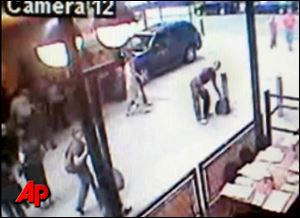
The New York City Police Department used surveillance video in its investigation of an attempted terror bombing in Times Square in 2010. The video included this person of interest, center right, leaving the area where a car bomb was found.
Obvious devices
All of the Toledo police cameras are obvious — they have blue flashing lights to indicate they’re working, recording, and feeding a live stream to the second floor of the downtown Safety Building, where cameras can be monitored around the clock.
“We want people to know that they’re there so that they can feel safe, and also so that the criminals know that, ‘Hey, this would not be a good location to do criminal activity,’ ” said Sgt. Joe Heffernan, police spokesman.
The cameras are provided through SkyCop Inc. of Memphis, whose Web site talks up the cameras as more effective than traditional community policing in catching “sophisticated criminals.” A representative of SkyCop declined to comment on Friday.
While a city councilman, Mayor Collins was skeptical of the camera plan — he worried that the city would “be putting cameras where we should be putting police officers” — although he ultimately supported it.
“I was hopeful we would do a phase-in program where we would have, with selective locations, looked at a smaller number of cameras and been able to better evaluate how they were affecting our ability to deliver a police service,” Mayor Collins said recently.
Although Sergeant Heffernan would not be specific, he said the cameras have drawn attention of researchers from “outside the area” who are working on “professional, academic studies” of the cameras and their relationship to decreasing crime in the city.
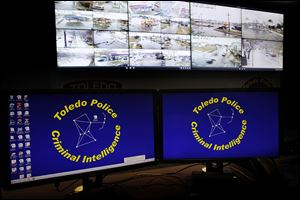
Video cameras display areas of the city in the Toledo Police Department’s real-time crime center at the Safety Building. These feeds have alerted police officers and led to crews being sent to crime scenes.
Drop in trouble
It appears Mr. Algazzawi’s belief that crime is dropping in the neighborhood around his store is spot-on.
In the six months before the camera outside his store was installed, there were 12 robberies, 13 aggravated assaults, 37 burglaries, 39 thefts, and six auto thefts. In the same six-month period the following year, each of the major-crime categories had fewer incidents, according to Toledo police data.
For the first month after the camera installation, business was down, Mr. Algazzawi said. Since then, business has picked up and grown. He has fewer “bad customers” and has gained “new, nice customers.”
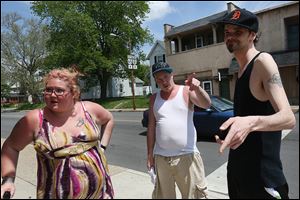
Heather Corum, left, with her brother Eric Camp, center, and Jeremy Loth, says the Toledo Police Department cameras installed in their East Toledo neighborhood haven’t made a positive difference.
Mixed reactions
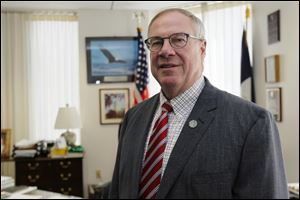
Toledo Mayor D. Michael Collins isn’t convinced about the effectiveness of police cameras and said he needs to do more research on crime data.
Since the camera plan was announced in December, 2011, reaction has been mixed. Proponents say they assist police in responding to incidents that might otherwise be unreported, and they can also deter crime.
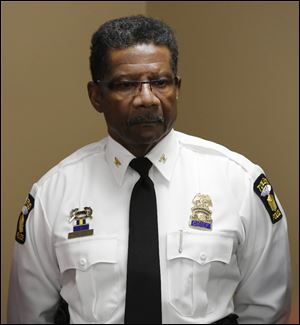
Toledo Police Chief William Moton has said the cameras ‘are an asset’ and ‘a positive attribute,’ but their effectiveness ‘remains to be seen.’
Opponents say the cameras are ineffective, can’t replace officers on the streets, and are an invasion of privacy.
“I was hoping it would cut down on drug activity,” said Heather Corum, who lives near a camera at Navarre Avenue and Oak Street in East Toledo. “Nobody cares. It’s made no difference at all. Right underneath it there are drug sales and fights. I’ve called police 20 to 30 times in the past month.”
Ms. Corum said the money spent on the cameras would have been better spent on hiring police officers.
The camera project cost the city $1.6 million, with funds coming from the law-enforcement trust fund that benefits from asset forfeitures, automobile auctions, and city capital-improvements dollars.
Sergeant Heffernan said the police cameras have been used to catch criminals, break up fights, and sort out stories after traffic crashes.
In August, three people who were allegedly stealing sandstone sidewalk from the 1200 block of Page Street were arrested after a camera operator at police headquarters noticed the suspects’ strange behavior. The officer was able to dispatch officers to the area and, within minutes, several crews were on scene and the suspects were arrested.
On April 11, a huge fight broke out behind the Greenbelt Place Apartments at about 8 p.m. A swell of people seemingly came out of nowhere and began to brawl. Someone monitoring one of the Walnut Street cameras noticed the melee and sent police to the scene. Two people were arrested.
Last year, when police were investigating the disappearance and slaying of Elaina Steinfurth, investigators relied on a police camera near the Maumee River to disprove Angela Steinfurth’s story about what happened to her 18-month-old daughter.
“When she was claiming she drove the baby down and threw [her] in the river, there was a camera down there on the only route you would take,” said Jeff Lingo, chief of the criminal division for the Lucas County Prosecutor’s Office. “We checked it. We didn’t see [her vehicle], which led us to believe it didn’t happen.”
The toddler’s remains were eventually found in a box behind the Federal Street home where she was last seen alive. Her mother and her mother’s boyfriend were convicted of murder and are serving life sentences.
Staff Writer Jennifer Feehan contributed to this report.
Contact Taylor Dungjen at tdungjen@theblade.com, or 419-724-6054, or on Twitter @taylordungjen.